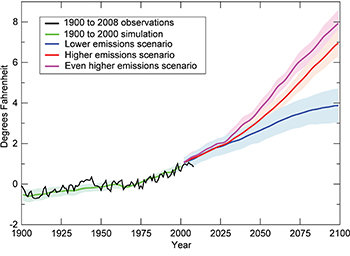Introduction
Greenhouse gases are capable of emitting and absorbing radiations [1]. Some of these gases include carbon dioxide, ozone, nitrous oxide, and methane. Greenhouse gases tend to affect the earth’s temperature and ocean levels. Human activities such as industrialization, energy production, and deforestation have contributed a lot to the increasing levels of greenhouse gases. In the future, greenhouse gases will increase unless human beings undertake new actions to reduce emissions. This paper will offer critical predictions of greenhouse gases.
Greenhouse Gases Predictions
From the mid 18th century, human beings have been clearing natural forests. Man has always burned fossils. The practice has significantly contributed to the increasing amount of carbon dioxide and other greenhouse gases in the atmosphere.
The level of such gases might increase in the coming years. This is true because human beings have failed to undertake adequate measures to deal with this problem. Some analysts believe that carbon dioxide emissions might go down. However, it is not quite clear whether this is achievable. It is agreeable that the future of the universe depends mostly on human activities. The current levels of carbon dioxide will reduce by 2100 if human beings undertake new measures to reduce emissions [1].

Some other experts expect global temperatures to have increased by 2100. If the level of greenhouse gases increases in the future, global temperatures will increase by 2.5-5.5 degrees centigrade by 2100. Some parts of the world will record larger temperature changes [2]. Changes in greenhouse gases affect global temperatures. This affects the quality of human life. The graph below shows different scenarios of projected greenhouse gas emissions by 2100 and possible temperature changes.

According to the above illustrations, greenhouse gas emissions will always be a major source of problems. The agreeable fact is that greenhouse gases in the atmosphere will be on the rise unless human beings come up with new strategies. Continued emissions of such gases will result in greater climate changes. Increased levels of greenhouse gas will result in new changes such as warmer oceans and atmospheres [3]. These gases will promote new changes such as increased sea levels and uneven precipitation patterns.
The ever-increasing levels of carbon dioxide and other greenhouse gases in the atmosphere will eventually increase global temperatures. The situation will reduce snow and ice cover. As well, greenhouse gases in the atmosphere will make oceans more acidic. Such changes will affect food production and availability [3].
This will affect human health, destroy infrastructure, and disorient ecosystems. The current shortage of water arises from changing weather changes. That being the case, the present and future greenhouse emissions will have tremendous impacts on climate and human life.
Conclusion
Most of the greenhouse gases remain in the atmosphere for very many years. This explains why global temperatures will be on the rise in the coming years. These temperatures will have greater impacts on ocean water thus affecting climatic patterns [4]. This discussion shows clearly that the extent of future changes will depend on what human beings do today in an attempt to reduce the emission of greenhouse gases.
The world will record larger climatic changes if human beings continue to emit more greenhouse gases. These changes will continue to affect food supply, ecosystems, health, infrastructure, and water resources. This discussion explains why human beings should come up with new strategies to reduce greenhouse gas emissions.
Reference List
- K. Beven. Environmental Modeling: An Uncertain Future? New York: CRC Press, 2010, pp. 45-49.
- E. Page. Climate Change, Justice and Future Generations. New York: Edward Elgar Publishing, 2007, pp. 72-75.
- D. Coley. Energy and Climate Change: Creating a Sustainable Future. New York: Wiley, 2008, pp. 65-68.
- I. Jones. Engineering Strategies for Greenhouse Gas Mitigation. Cambridge: Cambridge University Press, 2011, pp. 29-32.